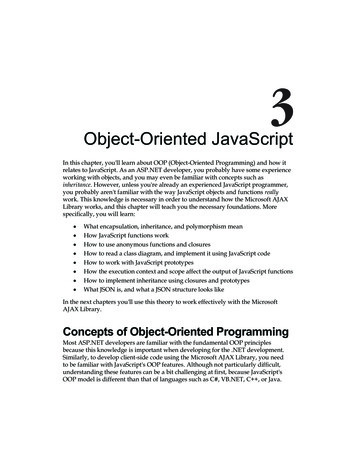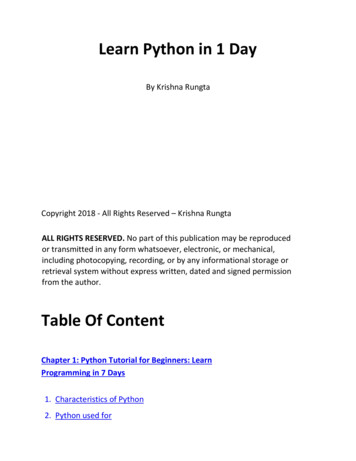
Transcription
Object Oriented Programmingin Python:Defining Classes
It’s all objects Everything in Python is really an object. We’ve seen hints of this already () These look like Java or C method calls. New object classes can easily be defined inaddition to these built-in data-types. In fact, programming in Python is typicallydone in an object oriented fashion.
Defining a Class A class is a special data type which defineshow to build a certain kind of object. The class also stores some data items that areshared by all the instances of this class Instances are objects that are created whichfollow the definition given inside of the class Python doesn’t use separate class interfacedefinitions as in some languages You just define the class and then use it
Methods in Classes Define a method in a class by includingfunction definitions within the scope of theclass block There must be a special first argument selfin all of method definitions which gets boundto the calling instance There is usually a special method calledinit in most classes We’ll talk about both later
A simple class def: studentclass student:“““A class representing astudent ”””def init (self,n,a):self.full name nself.age adef get age(self):return self.age
Creating and DeletingInstances
Instantiating Objects There is no “new” keyword as in Java. Just use the class name with ( ) notation andassign the result to a variable init serves as a constructor for theclass. Usually does some initialization work The arguments passed to the class name aregiven to its init () method So, the init method for student is passed“Bob” and 21 and the new class instance isbound to b:b student(“Bob”, 21)
Constructor: init An init method can take any number ofarguments. Like other functions or methods, thearguments can be defined with default values,making them optional to the caller. However, the first argument self in thedefinition of init is special
Self The first argument of every method is areference to the current instance of the class By convention, we name this argument self In init , self refers to the objectcurrently being created; so, in other classmethods, it refers to the instance whosemethod was called Similar to the keyword this in Java or C But Python uses self more often than Javauses this
Self Although you must specify self explicitlywhen defining the method, you don’t include itwhen calling the method. Python passes it for you automaticallyDefining a method:Calling a method:(this code inside a class definition.)def set age(self, num):self.age num x.set age(23)
Deleting instances: No Need to “free” When you are done with an object, you don’thave to delete or free it explicitly. Python has automatic garbage collection. Python will automatically detect when all of thereferences to a piece of memory have goneout of scope. Automatically frees thatmemory. Generally works well, few memory leaks There’s also no “destructor” method forclasses
Access to Attributesand Methods
Definition of studentclass student:“““A class representing a student”””def init (self,n,a):self.full name nself.age adef get age(self):return self.age
Traditional Syntax for Access f student(“Bob Smith”, 23) f.full name # Access attribute“Bob Smith” f.get age() # Access a method23
Accessing unknown members Problem: Occasionally the name of an attributeor method of a class is only given at run time Solution:getattr(object instance, string) string is a string which contains the name ofan attribute or method of a class getattr(object instance, string)returns a reference to that attribute or method
getattr(object instance, string) f student(“Bob Smith”, 23) getattr(f, “full name”)“Bob Smith” getattr(f, “get age”) method get age of classstudentClass at 010B3C2 getattr(f, “get age”)() # call it23 getattr(f, “get birthday”)# Raises AttributeError – No method!
hasattr(object instance,string) f student(“Bob Smith”, 23) hasattr(f, “full name”)True hasattr(f, “get age”)True hasattr(f, “get birthday”)False
Attributes
Two Kinds of Attributes The non-method data stored by objects arecalled attributes Data attributes Variable owned by a particular instance of a class Each instance has its own value for it These are the most common kind of attribute Class attributes Owned by the class as a wholeAll class instances share the same value for itCalled “static” variables in some languagesGood for (1) class-wide constants and (2)building counter of how many instances of theclass have been made
Data Attributes Data attributes are created and initialized byan init () method. Simply assigning to a name creates the attribute Inside the class, refer to data attributes using self—for example, self.full nameclass teacher:“A class representing teachers.”def init (self,n):self.full name ndef print name(self):print self.full name
Class Attributes Because all instances of a class share one copy of aclass attribute, when any instance changes it, the valueis changed for all instances Class attributes are defined within a class definition andoutside of any method Since there is one of these attributes per class and notone per instance, they’re accessed via a differentnotation: Access class attributes using self. class .name notation-- This is just one way to do this & the safest in general.class sample:x 23def increment(self):self. class .x 1 a sample() a.increment() a. class .x24
Data vs. Class Attributesclass counter:overall total 0# class attributedef init (self):self.my total 0# data attributedef increment(self):counter.overall total \counter.overall total 1self.my total \self.my total 1 1 3 2 3a counter()b my totala. class .overall totalb.my totalb. class .overall total
Inheritance
Subclasses Classes can extend the definition ofother classes Allows use (or extension) of methods andattributes already defined in the previous one To define a subclass, put the name ofthe superclass in parens after thesubclass’s name on the first line of thedefinitionClass Cs student(student): Python has no ‘extends’ keyword like Java Multiple inheritance is supported
Multiple Inheritance Python has two kinds of classes: old and new (moreon this later) Old style classes use depth-first, left-to-right access New classes use a more complex, dynamic approachclass AO(): x 0class BO(AO): x 1class CO(AO): x 2class DO(BO,CO): passao AO()bo BO()co CO()do DO() from mi import * ao.x0 bo.x1 co.x2 do.x1 /mi.py
Redefining Methods To redefine a method of the parent class,include a new definition using the same namein the subclass The old code won’t get executed To execute the method in the parent class inaddition to new code for some method,explicitly call the parent’s version of methodparentClass.methodName(self,a,b,c) The only time you ever explicitly pass ‘self’as an argument is when calling a method of anancestor
Definition of a class extending studentClass Student:“A class representing a student.”def init (self,n,a):self.full name nself.age adef get age(self):return self.ageClass Cs student (student):“A class extending student.”def init (self,n,a,s):student. init (self,n,a) #Call init for studentself.section num sdef get age():#Redefines get age method entirelyprint “Age: ” str(self.age)
Extending initSame as redefining any other method Commonly, the ancestor’s init method isexecuted in addition to new commands You’ll often see something like this in theinit method of subclasses:parentClass. init (self, x, y)where parentClass is the name of the parent’sclass
Special Built-InMethods and Attributes
Built-In Members of Classes Classes contain many methods andattributes that are always included Most define automatic functionality triggeredby special operators or usage of that class Built-in attributes define information that mustbe stored for all classes. All built-in members have doubleunderscores around their names:init doc
Special Methods E.g., the method repr exists for allclasses, and you can always redefine it repr specifies how to turn an instanceof the class into a string print f sometimes calls f. repr () toproduce a string for object f Typing f at the REPL prompt callsrepr to determine what to display asoutput
Special Methods – Exampleclass student:.def repr (self):return “I’m named ” self.full name. f student(“Bob Smith”, 23) print fI’m named Bob Smith f“I’m named Bob Smith”
Special Methods You can redefine these as well:init : The constructor for the classcmp : Define how works for classlen : Define how len( obj ) workscopy : Define how to copy a class Other built-in methods allow you to give aclass the ability to use [ ] notation like an arrayor ( ) notation like a function call
Special Data Items These attributes exist for all classes.doc : Variable for documentation string for classclass: Variable which gives you areference to the class from any instance of itmodule: Variable which gives a reference tothe module in which the particular class is defineddict:The dictionary that is actually thenamespace for a class (but not its superclasses) Useful: dir(x) returns a list of all methods and attributesdefined for object x
Special Data Items – Example f student(“Bob Smith”, 23) print f. docA class representing a student. f. class class studentClass at 010B4C6 g f. class (“Tom Jones”,34)
Private Data and Methods Any attribute/method with two leading underscores in its name (but none at the end) isprivate and can’t be accessed outside ofclass Note: Names with two underscores at thebeginning and the end are for built-inmethods or attributes for the class Note: There is no ‘protected’ status inPython; so, subclasses would be unable toaccess these private data either
Everything in Python is really an object. We’ve seen hints of this already “hello”.upper() list3.append(‘a’) dict2.keys() These look like Java or C method calls. New object classes can easily










